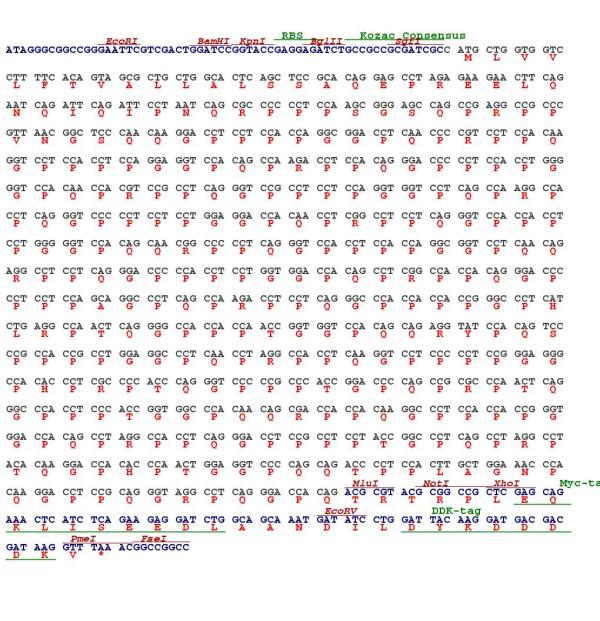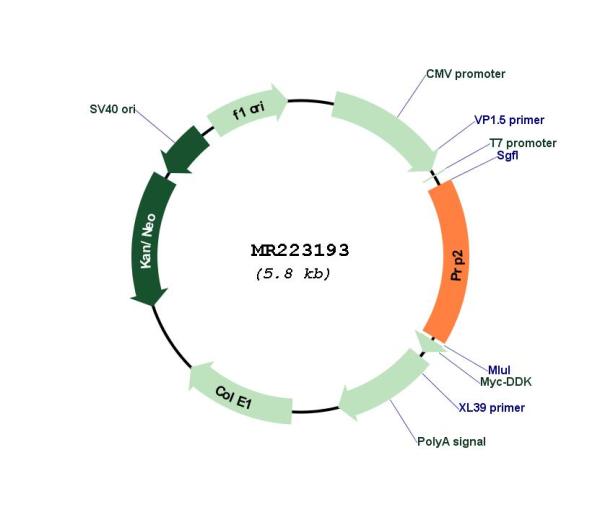Prp2 (NM_031499) Mouse Tagged ORF Clone
SKU
MR223193
Prp2 (Myc-DDK-tagged) - Mouse proline rich protein 2 (Prp2). Note: ORF is codon optimized
-
TrueORF®
TrueORF®
Expression-ready ORF plasmid with C-terminal tag(s)
Click here to learn more.
| Product Data | |
| Type | Mouse Tagged ORF Clone |
|---|---|
| Target Symbol | Prp2 |
| Synonyms | MP1; MP14 |
| Vector | pCMV6-Entry |
| E. coli Selection | Kanamycin (25 ug/mL) |
| Mammalian Cell Selection | Neomycin |
| Sequence Data |
ORF Nucleotide Sequence
>MR223193 representing NM_031499, codon optimized.
Due to the complexity of NM_031499, the ORF clone is codon optimized for mammalian Expression. The nucleotide sequence differs from the reference sequence, yet the amino acid sequence remains identical. Red=Cloning site Blue=ORF Green=Tags(s) TTTTGTAATACGACTCACTATAGGGCGGCCGGGAATTCGTCGACTGGATCCGGTACCGAGGAGATCTGCC GCCGCGATCGCC ATGCTGGTGGTCCTTTTCACAGTAGCGCTGCTGGCACTCAGCTCCGCACAGGAGCCTAGAGAAGAACTTC AGAATCAGATTCAGATTCCTAATCAGCGCCCCCCTCCAAGCGGGAGCCAGCCGAGGCCGCCCGTTAACGG CTCCCAACAAGGACCTCCTCCACCAGGCGGACCTCAACCCCGTCCTCCACAAGGTCCTCCACCTCCAGGA GGTCCACAGCCAAGACCTCCACAGGGACCCCCTCCACCTGGGGGTCCACAACCACGTCCGCCTCAGGGTC CGCCTCCTCCAGGTGGTCCTCAGCCAAGGCCACCTCAGGGTCCCCCTCCTCCTGGAGGACCACAACCTCG GCCTCCTCAGGGTCCACCACCTCCTGGGGGTCCACAGCAACGGCCCCCTCAGGGTCCACCTCCACCAGGC GGTCCTCAACAGAGGCCTCCTCAGGGACCCCCACCTCCTGGTGGACCACAGCCTCGGCCACCACAGGGAC CCCCTCCTCCAGCAGGCCCTCAGCCAAGACCTCCTCAGGGCCCACCACCACCGGGCCCTCATCTGAGGCC AACTCAGGGGCCACCACCAACCGGTGGTCCACAGCAGAGGTATCCACAGTCCCCGCCACCGCCTGGAGGC CCTCAACCTAGGCCACCTCAAGGTCCTCCCCCTCCGGGAGGGCCACACCCTCGCCCCACCCAGGGTCCCC CGCCCACCGGACCCCAGCCGCGCCCAACTCAGGGCCCACCTCCCACCGGTGGCCCACAACAGCGACCACC ACAAGGCCCTCCACCACCGGGTGGACCACAGCCTAGGCCACCTCAGGGACCTCCGCCTCCTACCGGCCCT CAGCCTAGGCCTACACAAGGACCACACCCAACTGGAGGTCCCCAGCAGACCCCTCCACTTGCTGGAAACC CACAAGGACCTCCGCAGGGTAGGCCTCAGGGACCACAG ACGCGTACGCGGCCGCTCGAGCAGAAACTCATCTCAGAAGAGGATCTGGCAGCAAATGATATCCTGGATT ACAAGGATGACGACGATAAGGTTTAA
Protein Sequence
>MR223193 representing NM_031499
Red=Cloning site Green=Tags(s) MLVVLFTVALLALSSAQEPREELQNQIQIPNQRPPPSGSQPRPPVNGSQQGPPPPGGPQPRPPQGPPPPG GPQPRPPQGPPPPGGPQPRPPQGPPPPGGPQPRPPQGPPPPGGPQPRPPQGPPPPGGPQQRPPQGPPPPG GPQQRPPQGPPPPGGPQPRPPQGPPPPAGPQPRPPQGPPPPGPHLRPTQGPPPTGGPQQRYPQSPPPPGG PQPRPPQGPPPPGGPHPRPTQGPPPTGPQPRPTQGPPPTGGPQQRPPQGPPPPGGPQPRPPQGPPPPTGP QPRPTQGPHPTGGPQQTPPLAGNPQGPPQGRPQGPQ TRTRPLEQKLISEEDLAANDILDYKDDDDKV |
| Restriction Sites |
SgfI-MluI Cloning Scheme for this gene
Plasmid Map

|
| ACCN | NM_031499 |
| ORF Size | 948 bp |
| OTI Disclaimer | The molecular sequence of this clone aligns with the gene accession number as a point of reference only. However, individual transcript sequences of the same gene can differ through naturally occurring variations (e.g. polymorphisms), each with its own valid existence. This clone is substantially in agreement with the reference, but a complete review of all prevailing variants is recommended prior to use. More info |
| OTI Annotation | This clone was engineered to express the complete ORF with an expression tag. Expression varies depending on the nature of the gene. |
| Components | The ORF clone is ion-exchange column purified and shipped in a 2D barcoded Matrix tube containing 10ug of transfection-ready, dried plasmid DNA (reconstitute with 100 ul of water). |
| Reconstitution Method | 1. Centrifuge at 5,000xg for 5min. 2. Carefully open the tube and add 100ul of sterile water to dissolve the DNA. 3. Close the tube and incubate for 10 minutes at room temperature. 4. Briefly vortex the tube and then do a quick spin (less than 5000xg) to concentrate the liquid at the bottom. 5. Store the suspended plasmid at -20°C. The DNA is stable for at least one year from date of shipping when stored at -20°C. |
| Note | Plasmids are not sterile. For experiments where strict sterility is required, filtration with 0.22um filter is required. |
| Shipping | Ambient |
| Reference Data | |
| RefSeq | NM_031499.1, NM_031499.2, NP_113687.2 |
| RefSeq Size | 951 bp |
| RefSeq ORF | 951 bp |
| Locus ID | 83380 |
| Cytogenetics | 6 G1 |
| MW | 31.8 kDa |
| Summary | This gene encodes a member of the heterogeneous family of proline-rich salivary glycoproteins. The expression of this gene is dramatically induced in the parotid and submandibular glands of mice by beta-adrenergic stimulation. The encoded protein serves an important dental function by protecting mice against toxic dietary polyphenols such as tannins and influence the visco-elastic properties of the mucus. This gene is located in a cluster of closely related salivary proline-rich proteins on chromosome 6. [provided by RefSeq, Nov 2015] |
Write Your Own Review
| Product Manuals |
| FAQs |
| SDS |
Citations
*Delivery time may vary from web posted schedule. Occasional delays may occur due to unforeseen
complexities in the preparation of your product. International customers may expect an additional 1-2 weeks
in shipping.






